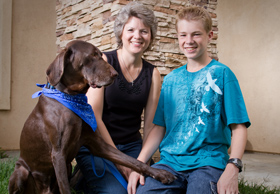By B.J. Walk

Fourteen-year-old Evan Jones — with mom, Charlete, and canine pal, Herman — does an incredible job of managing his type 1 diabetes.
Charlete Jones remembers a nagging sense of dread as she watched her toddler, Evan, begin to display unusual symptoms.
“Over a month or so, he started drinking a lot of fluid and soaking through doubled diapers,” she said. “He was fussy and irritable and was losing weight. I knew from my grandmother’s experience that these could be signs of type 1 diabetes. But when I called my doctor’s office, the nurse said he couldn’t have diabetes because he was so young.”
Over time, more problems appeared and, at 17 months, Evan took a sharp turn for the worse. “After not being able to keep much food or drink down, he woke one morning with dark circles under his eyes and started having trouble breathing,” Charlete said.
She rushed him to his doctor, who at first thought Evan was having an asthma attack. But he soon determined that Evan had diabetic ketoacidosis, a dangerous complication of type 1 diabetes that can lead to death.
“His blood sugar was so high that doctors put him in a coma, so they could slowly bring it down,” Charlete said.
Soon, Evan was on his way to Rady Children’s Hospital-San Diego, where he spent four days in the intensive care unit. He then became a patient of Michael Gottschalk, M.D., Ph.D., chief of the Endocrinology/Diabetes Division at Rady Children’s and clinical professor, the University of California, San Diego School of Medicine. Rady Children’s offers a comprehensive diabetes program to help children and their families manage the disease. Caring for more than 1,000 children with diabetes each year, the program is consistently ranked by U.S. News & World Report as one of the best pediatric diabetes and endocrinology programs in the nation.
Dr. Gottschalk noted that Evan’s diabetes diagnosis, at such a young age, reflects a trend in the United States and around the world. “It used to be that most type 1 diabetes cases presented in children around puberty,” he said.
“But now an equal number of cases are presenting in this very young group of children, under the age of 5, and no one knows why.”
For Evan, now 14, diabetes is simply a way of life. He watches his diet, is active and wears an insulin pump on his waist, which looks more like a pager than a sophisticated medical device.
Dr. Gottschalk said Evan’s blood sugar has been well-controlled, largely due to the care of his supportive family.
“They have done an incredible job of controlling his disease,” Dr. Gottschalk said. “Even though we’re treating Evan, type 1 diabetes requires a lot of attention to a daily regimen of insulin, carbohydrate values, and being prepared to intervene if blood glucose goes too low or too high. Nobody gets a vacation from type 1 diabetes.” As if living with diabetes was not difficult enough, Evan must also deal with celiac disease, which he developed in 2006.
Triggered by foods containing gluten, such as wheat, celiac disease causes inflammation of the intestines. “Children with type 1 diabetes have an increased risk of developing celiac disease,” said Kimberly Newton, M.D., director of Rady Children’s Pediatric Celiac Disease Center and Evan’s doctor.
The only treatment for celiac disease is strict adherence to a gluten-free diet. “This can be challenging for children with type 1 diabetes, who already have dietary restrictions,” Dr. Newton said. “But the good news is that most children, like Evan, can learn and adapt to a diabetic, gluten-free diet quite well and thrive.”
For his part, Evan seems to take everything in stride, testing his blood sugar about six times a day with a finger stick and learning to handle all aspects of his care as part of becoming more independent.
“The last thing I’m working on is learning to change the infusion site of my insulin pump,” he said. The infusion site must be changed every three days and requires inserting an infusion needle in the stomach.
He added, “No one wants to put a needle in their body on purpose. But I’m getting better at it.”
Evan is also getting plenty of support from his entire family.
“My dog, Herman, comes over and sits by me,” Evan said with a smile. “He knows it’s time for the pump change.”
For more information about Rady Children’s Diabetes Program, click here.
The San Diego Union-Tribune Kids’ NewsDay, October 2011